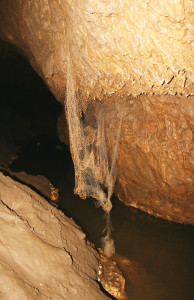In 2010, two undergraduates from Lawrence University and my colleague, Rai Gomez from Philippine Biodiversity Conservation Foundation, and I in collaboration with the Department of Environment and Natural Resources (DENR) surveyed bat populations in caves on Siquijor Island. Being a relatively small karst-covered island with a long history of human occupation, and very little forest we were interested in learning how cave bats were faring on the island. We visited 20 large caves in order to find out.
Many signs of past cave disturbance
Despite the fear-filled talk of cave-dwelling aswang, people apparently have boldly entered caves and exploited cave resources on the island for a very long time. While many caves rarely had human visitors, evidence of past visits was obvious. In some caves all resources worth extracting had been taken years ago—stalactites, phosphate, guano and the bats that produced the guano. Many caves had chambers reminiscent of vast, abandoned and dust-covered mansions in horror movies—eerie and rich with untold stories of more lively days. The wall of one cave declared: “guano discovered here in 1970.”
I give a full account of our findings in the attached report below, but overall the news was not good. For now can I just hope that there remain some undiscovered caves providing refuge for Siquijor’s bats.

